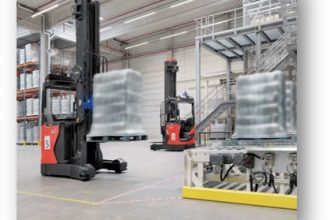AGVs and AMRs in One Facility

In the midst of a historic labor shortage, more and more companies are turning to mobile vehicles to assist in operations. These can take on two main forms, automated guided vehicles (AGVs) and autonomous mobile robots (AMRs). Each has its pros and cons, and each are better suited for particular applications. In some cases, facilities are now using both, or even turning to robots that feature the characteristics of both.
AGVs are the oldest type of automated vehicles, existing for several decades now, although they have greatly evolved over the years, as well. An AGV navigates a facility via guided pathways set by magnetic tape or wire, painted lines, or laser targets. AGVs can move quickly, operate in a predictable—and therefore very safe and efficient—pattern, and are lower cost than AMRs. If your facility has a high level of forklift traffic, an AGV might be your best bet because it will greatly lower the odds of a collision.
AMRs, on the other hand, have free roam of a facility, generally moving from point A to point B. They can navigate around obstacles if they are in their path, and work best in goods to person environments. The cons to AMRs include speed and cost.
While having one or the other is still the most common scenario, increasingly, companies are operating with both vehicles, sometimes one complementing the other. There are also scenarios where one vehicle features the characteristics of both.
In situations where you might want to consider having both AGVs and AMRs, you’ll likely have two different types of operations under one roof. This might be a retailer’s warehouse, as an example, where the facility supports both traditional brick-and-mortar storefronts, and e-commerce as well.
For instance, you might have a section of your facility dedicated to a relatively steady, unchanging work flow—the bricks-and-mortar side of the business. This is a good place to install AGVs due to their predictability and reliability. They deliver materials and goods from storage to a designated drop-off point and then return to their starting point to do it all again.
If you have a more dynamic side of the building—where you fulfill rapid-fire e-commerce orders, AMRs might be the right solution due to their flexibility. Not dependent on fixed routes, you can reprogram your AMRs easily on site or even from a remote location. As your order mixes and operations evolve and change, AMRs can best serve that side of your facility.
In some cases, you can purchase vehicles that share both characteristics. These “best of both worlds” vehicles might operate chiefly as an AMR. However, when the need arises for them to operate more predictably—such as when there are lots of people and forklifts in an area—you can switch the operating software and place your AMRs on a more predictable path, ala an AGV.
Consult with your automated vehicle partner to learn the best approach for your particular facility.
To find out more about MHI’s MAG Industry Group: https://www.mhi.org/mag
To learn more about how mobile automation can benefit you:
How To Make Mobile Automation Affordable
Understanding The Differences Between AGVs And AMRs
Discover How Mobile Automated Vehicles Enhance A Variety Of Material …
How Mobile Autonomous Vehicles Address E-Commerce, Automotive And Food/Beverage Handling …



